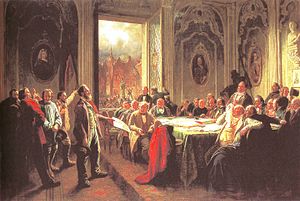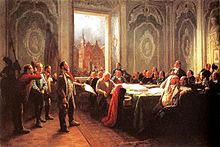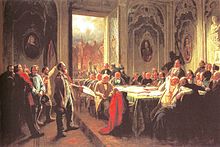Workers in front of the magistrate

|
| Workers in front of the magistrate |
|---|
| Johann Peter Hasenclever , 1848–1850 |
| Oil on canvas |
| 154 x 225.4 cm |
| Museum Kunstpalast Düsseldorf |
Workers in front of the magistrate , contemporary also workers and city councilors or a city councilor from 1848 , is the title of a major work by the Düsseldorf genre painter Johann Peter Hasenclever . The oil painting , which is one of the early socially critical creations of the Düsseldorf School of Painting , shows workers handing over a petition to a city council in the revolutionary year 1848 . The event picture is considered to be the first representation of self-confident workers in German painting.
Historical background
The picture Workers at the Magistrates has a real historical background: On 9 October 1848 delegation ranged from 600 become unemployed workers in the council of the city of Dusseldorf a petition with the request for reinstatement one. Their municipal employment program, which had consisted of emergency work on Golzheim Island , had expired shortly before. However, since the funds provided by the city of Düsseldorf were exhausted, the petitioners received a negative answer from the local council. The day before, many of the petitioners had at a major demonstration with about 5,000 participants in the near Gerresheim participated in which they support the her call for continuation of a local employment program Socialist People's clubs had received a political union of the early labor movement in Dusseldorf, in whose leadership in particular, the lawyers Ferdinand Lassalle and Julius Wulff and the poet Ferdinand Freiligrath were engaged.
These events were embedded in the German Revolution of 1848/1849 , in which, after the February Revolution of 1848 , Germany's social, economic and political problems that had accumulated in Vormärz were released. The climate in Düsseldorf, the seat of parliament of the Prussian Rhine Province , was also tense. Various political circles had formed there in which the citizens discussed a new constitution and made political demands. Julius Wullf was in a meeting of its popular clubs on July 3, 1848 Max Cohn home pamphlet Republican catechism before, which ended with the call for establishment of a "German Democratic Republic". Shortly afterwards the Prussian state organs had him arrested for high treason and taken to the Düsseldorf prison. In this situation Freiligrath wrote the revolutionary poem Die Todten an die Leben in July 1848 . In it, Freiligrath, a staunch republican and supporter of popular sovereignty , mocked the Prussian King Friedrich Wilhelm IV. As a "dismissed man". On August 14, 1848, a few days after the citizens of Düsseldorf had celebrated the festival of German unity with the demand for a united and democratically governed Germany and for a constitutional restriction of the monarchy, the king came to Düsseldorf in person. There he wanted to pay a visit to his cousin, the Düsseldorf division commander Friedrich von Prussia . On the way to his residence, Schloss Jägerhof , the sovereign traveling in an open carriage on Kastanienallee (today Königsallee ) was greeted with whistles from a grim crowd and pelted with horse droppings. When the Prussian military then took action against citizens on the streets of the garrison town, the Düsseldorf vigilante formed in March 1848 under their commander Lorenz Cantador intervened against the military and restored order and calm. Eleven of the 66 vigilante officers elected were painters, the painter Hasenclever was a deputy platoon leader.
Hasenclever first made a watercolor on a pencil drawing ( Städtisches Museum Remscheid ) and a sketch in oil ( Westfälisches Landesmuseum Münster ) of the appearance of the workers in Düsseldorf City Hall . Shortly afterwards, he created oil paintings in which Hasenclever treated his motif of the workers' petition in different variations:
First version in oil ( Bergisches Museum Schloss Burg an der Wupper )
Second version in oil ( Museum Kunstpalast Düsseldorf )
Image description
In the main version, which is being kept in the Düsseldorf Museum Kunstpalast and created between 1848 and 1850, a council chamber is shown in oil on canvas with dimensions of 154 × 225.4 cm as the meeting place for a city council. In the right half of the picture, the councilors are gathered around a large table on which there are books, papers and writing utensils. A file on the table bears the year 1848. In the left half of the picture are six representatives of the unemployed workers and, through their leader, hand over the petition. The walls of the council chamber are decorated in rococo and plait style, as well as oval medallions with portraits of rulers with allonge wigs . In the center of the picture, the gaze falls through an open window onto a market square lined with town houses , on which a political rally with excited participants is taking place under a stormy sky. The black, red and gold flag and a red flag are shown above the heads of the participants in this rally . Also raised, near a statue of St. George in the middle of the square, is a man in bourgeois clothes, with arms outstretched and a paper in his hand, giving a speech to the crowd. The daylight that falls into the council chamber through the open window illuminates the councilors' large table and part of the wall behind it, on which there is a plaster bust with the portrait of the sovereign Friedrich Wilhelm IV and a picture with a removable frame hung underneath. This picture shows an engraving with the portrait of the imperial administrator Johann von Österreich . The glass in this picture has cracked. In one corner of the room there is a dark armor with a halberd . To the left of the window is a black, red, and gold flag on the wall.
Both the councilors and the pleading workers are shown in different postures and gestures, clothing of varying color and quality, and differentiated physiognomies. Particularly noticeable is a somewhat stocky councilor with a yellow vest and gold watch chain in the foreground of the right half of the picture, who wipes the sweat from his face with a large handkerchief. On the side of the petitioners that their with cockades decreased ornate headgear, their leader is highlighted by the gesture of the presentation of the petition and its laborers from the other something abgerückte position in the forefront of the left half. Most of the councilors' eyes are on his sunlit face.
interpretation

Hasenclever's picture does not show the specific Düsseldorf Council Hall or the specific Düsseldorf market square , but rather depicts these rooms in a generalized form in order to describe the March Revolution of 1848 in the Rhineland in its general meaning that goes beyond the local area. At the same time, parallels can be recognized which, for the local observer, relate to the events in Düsseldorf that provide the context in which the picture was created. The statue of St. George corresponds to the Jan Wellem equestrian monument , and the church, the tower of which protrudes over the gables of the town houses on the market square, is similar to the Lambertus Church in Düsseldorf . In addition to the year 1848 on the file on the table, the portrait of the Reichsverwalter Johann von Österreich as well as the black, red and gold flags and cockades indicate the events and political program of the March Revolution in the Kingdom of Prussia , whose ruler Friedrich Wilhelm IV Representative of the Ancien Régime was perceived. The rococo and plait style room decor of the council chamber, which at the time the picture was created, and the dark knight's armor as a specter of a distant past, indicate that the painter wanted to symbolically depict the prevailing political conditions as obsolete or backward. Even the councilors, whom the painter ridiculed by satirically exaggerating their sometimes perplexed and anxious, sometimes uninterested mines and gestures, appear in an ironic, critical light. In particular, the sweating councilor with a yellow vest and a gold watch chain is caricatured in Balzac fashion as a representative of the property bourgeoisie, to whom the social demands of the pleading workers as representatives of the “ working class ” and the revolutionary rally on the market square as a political response to “ pauperism ” and the " Social question " instill fears about positions and assets. In contrast, the leader of the workers appears very serious, with which the painter expresses a fundamental agreement with the demands of the workers.
Exhibition, reception and whereabouts

Hasenclever's picture was taken from Freiligrath to London on May 12, 1851 on his escape . After exhibitions in London (summer 1851) and Manchester (summer 1852), it was exhibited in New York's Crystal Palace for the Exhibition of the Industry of All Nations in 1853 . Karl Marx may have seen the picture in London. In an article in the New York Daily Tribune on August 12, 1853, which he had written at Freiligrath's request, he wrote about Hasenclever and the event described in the picture: “The outstanding painter has it in all its dramatic vitality reproduced what the writer could only analyze. ” He was referring to his own series of articles, Revolution and Counterrevolution in Germany , written with Friedrich Engels . With the painters of the 19th century, the painting achieved a great role model effect in cooperation with other pictures of the " tendency painting " of the Düsseldorf school. B. on Axel Kulle's genre painting Der Kirchenvorstand (motif from Germany) from 1877 .
In January 1854 the painting was honored by the jury with an "Honorable Mention" at the exhibition at the New York Crystal Palace. Since Hasenclever had died the previous month, he could no longer experience this success. In order to cope with the financial problems of Hasenclever's widow and his own financial problems, Freiligrath subsequently undertook to sell the picture in a series of other Hasenclever pictures. He managed to sell the picture to the Philadelphia art collector Ferdinand J. Dreer , who exhibited it at least three times, in 1855 and 1857, and in 1877 at the Pennsylvania Academy of the Fine Arts in Philadelphia. It later went to the collection of Victoria Dreyfus (1881–1976) from Brewster, New York. In October 1976 it was auctioned off by Sotheby Parke Bernet . There it was auctioned by the Paffrath Gallery . In 1978 the Museum Kunstpalast was able to acquire the picture with the support of the State of North Rhine-Westphalia . Since then, it has been a focus in the collection there in the art-historical-museum communication of the painting of the Düsseldorf School.
literature
- Hanna Gagel: The Düsseldorf school of painting in the political situation of the Vormärz and 1848. In: Wend von Kalnein (ed.): The Düsseldorf school of painting . Verlag Philipp von Zabern, Mainz 1979, ISBN 3-8053-0409-9 , p. 68 ff.
- Kurt Soiné: Johann Peter Hasenclever. A painter in the pre-March period . Bergische Forschungen, 21, Neustadt / Aisch 1990, pp. 166-190
- Kathrin DuBois: Worker in front of the magistrate, around 1848/50. In: Bettina Baumgärtel (Hrsg.): The Düsseldorf School of Painting and its international impact 1819–1918 . Michael Imhof Verlag, Petersberg 2011, ISBN 978-3-86568-702-9 , Volume 2, p. 310 f. (Catalog No. 261)
Web links
- Workers in front of the magistrate in the German Digital Library
- The strike in art , website in the portal dhm.de ( German Historical Museum )
Individual evidence
- ↑ Workers in front of the magistrate , data sheet and explanation of the oil sketch of the same name (inv.no.270 WKV) in the LWL Museum for Art and Culture, accessed on the lwl.org portal on May 8, 2016
- ↑ Margaret A. Rose: Painted Politics. JP Hasenclever's Worker and Councilor from 1848 and 1850 . In: Norbert Otto Eke, Bernd Füllner (Eds.): Forum Vormärzforschung Yearbook 2015 . Aisthesis-Verlag, Bielefeld, p. 185 ff .
- ^ Original text in English in the New York Daily Tribune of August 12, 1853: What the writer could only analyze, the eminent painter has reproduced in its dramatic vitality .
- ↑ Cf. Friedrich Engels: Revolution and Counterrevolution in Germany . Website in the mlwerke.de portal ( Karl Marx - Friedrich Engels - Werke , Volume 8, Dietz Verlag, Berlin / GDR 1960, pp. 5–108)
- ^ Albert Boime : Social Identity and Political Authority in the Response of Two Prussian Painters to the Revolution of 1848 . In: Art History . Vol. 13, No. 3, September 1990, p. 350 ( PDF )

